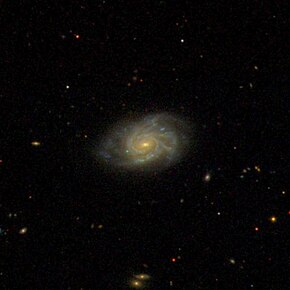NGC 5416 is a spiral galaxy and radio galaxy[1] located in the constellation Boötes. Its speed relative to the cosmic microwave background is 6,499 ± 18 km/s, which corresponds to a Hubble distance of 95.9 ± 6.7 Mpc (∼313 million ly).[2] NGC 5416 was discovered by German-British astronomer William Herschel in 1784.
| NGC 5416 | |
|---|---|
 | |
| Observation data (J2000 epoch) | |
| Constellation | Boötes |
| Right ascension | 14h 02m 11s |
| Declination | +09° 26’ 24” |
| Redshift | 0.020811 |
| Distance | 313 Mly (95.86 Mpc) |
| Apparent magnitude (B) | 13.6 |
| Surface brightness | 22.79 mag/arcsec^2 |
| Characteristics | |
| Type | SAc |
| Size | 114,000 ly (estimated) |
| Apparent size (V) | 1.37' x 0.75' |
| Other designations | |
| PGC 49991, UGC 8944, IRAS 13597+0940, CGCG 074-052, MCG +02-36-014 | |
The luminosity class of NGC 5416 is III-IV and it has a broad HI line.[2] According to the SIMBAD database, NGC 5416 is a radio galaxy.[1]
To date, 25 non-redshift measurements yield a distance of 80.152 ± 12.462 Mpc (∼261 million ly),[3] which is within the Hubble distance values. Note that it is with the average value of independent measurements, when they exist, that the NASA/IPAC database calculates the diameter of a galaxy and that consequently the diameter of NGC 5416 could be approximately 41, 8 kpc (∼136,000 ly) if we used the Hubble distance to calculate it.[4]
NGC 5423 group
editNGC 5416 is part of the NGC 5423 group, the brightest galaxy in this group. This group of galaxies has at least four members. The other three galaxies in the group are NGC 5409, NGC 5423 and NGC 5424.[5]
See also
editExternal links
editReferences
edit- ^ a b "NGC 5416". simbad.u-strasbg.fr. Retrieved 2024-07-21.
- ^ a b "By Name | NASA/IPAC Extragalactic Database". ned.ipac.caltech.edu. Retrieved 2024-07-21.
- ^ "NED Query Results for NGC 5416". ned.ipac.caltech.edu. Retrieved 2024-07-21.
- ^ "NGC catalog objects Table". astrovalleyfield.ca. Retrieved 2024-07-21.
- ^ Mahtessian, Abraham (July 1998). "Groups of galaxies. III. Some empirical characteristics". ResearchGate. Retrieved July 20, 2024.